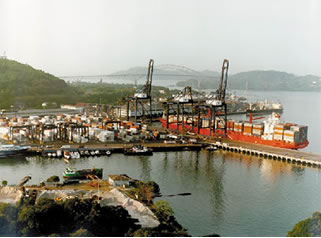
PANAMA CANAL FACTS |
|
|---|---|
The Panama Canal connects the Atlantic and Pacific Ocean through a 45 nautical mile gap that cuts across the Isthmus of Panama. The Canal started operations in 1914 and was run by the Americans between 1914 and 1999. The Panamanians have been running the Panama Canal effectively since December 31 st , 1999. The Canal can accommodate ships from small private yachts to large ships. The most important limiting factor for ships going through the Panama Canal is the size of the locks. The lock chambers are 110 feet wide (33.53 meters) and the length is 1000 feet (304.8 meters). The available water depth in the lock chambers varies, but the least depth is 12.9 meters (m) at the South end of the Pedro Miguel locks. Currently, Panamax ships are the largest ships that can go through the Panama Canal. |
|
Due to a growing market on the construction of Post Panamax Ships and an ever expanding world trade, the Panama Canal Authority (PCA) wants to expand the Canal by building a Third Set of locks that can hold Post Panamax ships. There are also other factors that will present limitations to ship transiting the Panama Canal. These factors are the following: the level of the water at the Gatun Lake, the ship's hull configuration, and a maximum air draft of 190 feet. In case there are any other restrictions, the Panama Canal Authority will inform their clients on their website under Notices to Shipping. |
|
The controlling depth on the Atlantic approach channels is 12.8 m. The controlling depth at the Pacific end, between buoys 1 and 2, is 12.9 m. The maximum permitted draught for canal transits is set at 12.04 m. (39' 06") in Tropical Fresh Water at a Lago Gatun level of 24.84m or higher. The maximum allowable height (air draft) for any ship transiting the Panama Canal or arriving the Port of Balboa is 57.91 m (190 feet) at any tide. The Panama Canal Authority can issue a special permit to allow a ship with an air draft of 62.5 m (205 feet) to pass at Balboa during MLWS (mean low water spring). Pilotage is compulsory in Canal waters According to the Panama Canal Authority, the pilot assigned to a vessel has the control of the navigation and movement of such vessel. The Panama Canal is the only place in the world where the pilots takes over the command of the vessel instead of acting as an advisor to the Master of the vessel. No one does anything onboard until the pilot orders it done. |
|
United Canal Agents
